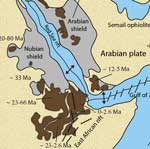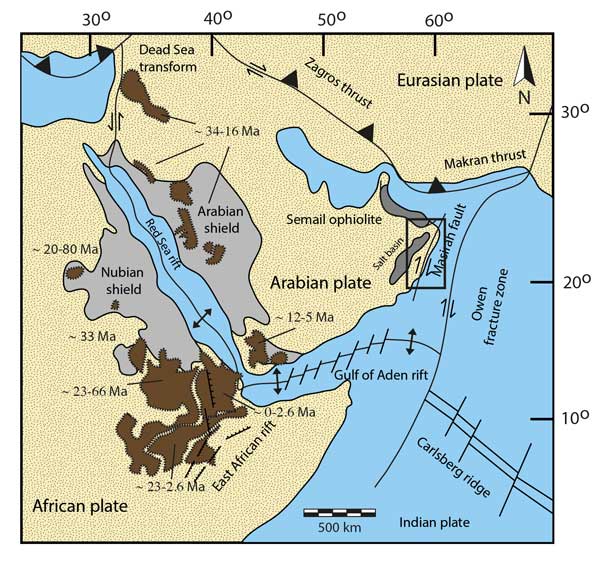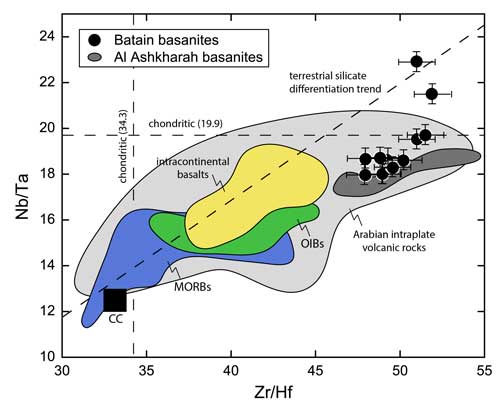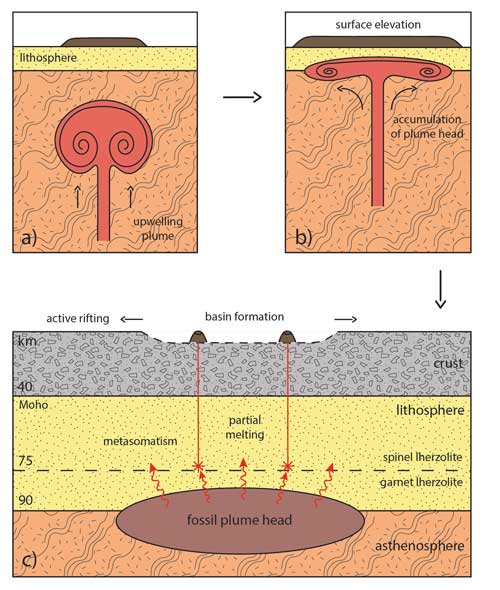 |
OIB signatures in basin-related lithosphere-derived alkaline basalts from the Batain basin (Oman) – Constraints from 40Ar/39Ar ages and Nd-Sr-Pb-Hf isotopes |
M. Witte1, S. Jung2, J.A. Pfänder3, R.L. Romer4, B. Mayer5, D. Garbe-Schönberg6
1GEOMAR - Helmholtz Center for Ocean Research, Dynamics of the Ocean Floor, Magmatic and Hydrothermal Systems, Wischhofstraße 1-3, D-24148 Kiel, Germany,mwitte@geomar.de;
2Fachbereich Geowissenschaften, Mineralogisch-Petrographisches Institut, Universität Hamburg, 20146 Hamburg, Germany, stefan.jung@uni-hamburg.de; stefan.jung@uni-hamburg.de
3Institut für Geologie, Technische Universität Freiberg, Bernhard-von-Cotta-Str. 2, 09599 Freiberg/Sachsen, FRG, Germany, pfaender@tu-freiberg.de
4Helmholtz-Zentrum Potsdam, Deutsches GeoForschungsZentrum GFZ, Telegrafenberg, 14473 Potsdam, Germany, romer@gfz-potsdam.de
5Department of Earth, Ocean, and Atmospheric Science & National High Magnetic Field Laboratory, Florida State University, 1800 E. Paul Dirac Drive, Tallahassee, FL 32310, United States, mayer@magnet.fsu.edu
6Institut für Geowissenschaften, Abteilung Geologie, Universität Kiel, Ludewig-Meyn-Straße 10, 24118 Kiel, Germany, dgs@gpi.uni-kiel.de
This webpage is a summary of Witte, M., S. Jung, J.A. Pfänder, R.L. Romer, B. Mayer, D. Garbe-Schönberg, OIB signatures in basin-related lithosphere-derived alkaline basalts from the Batain basin (Oman) — Constraints from 40Ar/39Ar ages and Nd–Sr–Pb–Hf isotopes, Lithos, 286-287, 109-124
A serious controversy on the origin of rift-related continental basalts exists that is mainly a consequence of different interpretations of geochemical data and the tectonic setting in which the rocks occur. Interpreting such data may yield ambiguous results because the interplay of depleted or enriched asthenospheric mantle, lithopheric mantle and continental crust during magma genesis can impart similar characteristics to continental basalts. However, there is some consensus that the source of common alkaline volcanic rocks erupted in continental areas is either the subcontinental lithospheric mantle, the shallow asthenospheric mantle, deep-plume-related mantle, or a combination of these three. Another issue is whether intra-continental rift-related volcanism is generated by adiabatic decompression melting caused by thinning of the lithosphere during rifting, or by raised mantle temperatures as a consequence of mantle plume activity.
We present comprehensive major and trace element and Nd, Sr, Pb, Hf isotope data as well as whole-rock 40Ar/39Ar ages from basin-related alkaline volcanic rocks from the Batain basin, Oman, to provide qualitative and quantitative constraints on partial melting processes and the composition of the mantle source involved during petrogenesis. We thereby address the important point whether a modern plume source (the Afar plume) or a fossil plume source affected the source composition of the Oman alkaline lavas.
The basanites studied here occur in the Batain basin that is part of the Mesozoic-Tertiary cover of the Arabian shield (Figure 1). The morphological expression of these extrusives is isolated volcanic plugs on the Batain plain. They were sampled over an area of about 1000 km2 and do not represent a single magmatic event but reflect magmatic activity that lasted for about 5.5 Ma with continuous magma eruptions from 40.7 ± 0.7 to 35.3 ± 0.6 Ma. There is no clear geographic trend in the distribution of ages and it is concluded that the monogenetic volcanic centers simply used pre-existing zones of weakness in the crust during eruption. During this period the magma composition remained nearly constant suggesting that the degree of melting and the nature of the tapped source did not change significantly over time.

Figure 1: Map of the Arabian region showing major plate boundaries, the outline of the Arabian–Nubian Shield and the distribution of major Oligocene-to-Recent western Arabian volcanic fields (modified after Krienitz & Haase, 2011). The rectangle shows the location of the working area within the Batain basin.
The basanites are relatively primitive in composition with low SiO2 (42.5 – 45.6 wt.%), high MgO (9.7 – 13.0 wt.%) and moderate to high Cr and Ni contents (Cr > 261 ppm, Ni > 181 ppm), with some being more differentiated and having undergone fractionation of mainly olivine and magnetite. Trace-element and Sr-Nd-Pb isotope data indicate that assimilation of crustal material did not affect the lavas.
A non-modal batch melting model (Shaw, 1970) using variations of La/Yb and Dy/Yb was used to constrain the degree of partial melting of spinel- or garnet-peridotite mantle sources. In terms of La/Yb vs. Dy/Yb the basanites display a trend that is consistent with an amphibole- and spinel-bearing peridotite source that experienced 4-13 % melting. Positively correlated La/Yb and Dy/Yb ratios indicate that some basanites may represent mixtures of melts from spinel and garnet peridotite. Negative Rb and K anomalies in a primitive-mantle normalized trace element diagram imply that a hydrous mineral phase, most likely amphibole, was present in the mantle source during partial melting (Wilson & Downes, 1991). Amphibole, however, is not stable in the convective upper mantle or in mantle plumes (Class & Goldstein, 1997) and therefore generation of the basanitic magmas likely occured within the lithospheric mantle. New pressure-temperature calculations by Lee et al. (2009) are compatible with this view implying that melting started at the base of the lithospheric mantle close to the spinel-garnet lherzolite transition zone at approximately 70-80 km depth.
High Field Strength Element (HFSE) systematics (in particular Zr/Hf and Nb/Ta) were used to constrain mantle source heterogeneities and the interplay between asthenospheric and lithospheric mantle derived melts (Pfänder et al., 2012). In the Batain basanites Nb/Ta ratios as well as Nb concentrations are higher than in OIBs (Münker et al., 2003; Pfänder et al., 2007), but within the range of continental basalts (Figure 2). Elevated Nb/Ta in continental basalts compared with OIBs can be explained by a Nb excess imprinted on the primary magmas by the addition of lithosphere-derived melts generated from carbonatized/ metasomatized domains in the lithospheric mantle (Pfänder et al., 2012). The isotope compositions of the basanites show restricted variations of 87Sr/86Sr and 143Nd/144Nd ranging from 0.70340 to 0.70405 and 0.51275 to 0.51284, respectively. Variations in their Pb isotopes (206Pb/204Pb: 18.59-18.82, 207Pb/204Pb: 15.54-15.56, 208Pb/204Pb: 38.65-38.98) fall in the range of most OIB.

Figure 2: Nb/Ta vs. Zr/Hf variation of the Batain basanites. Chondritic values and the terrestrial silicate fractionation trend as well as fields for continental crust (CC), MORBs, OIBs and intracontinental basalts are from Pfänder et al. (2012) and based on high-precision concentration data obtained by isotope dilution methods. Error bars on data points represent an uncertainty of ± 5%, estimated from the analytical reproducibility of concentration measurements.
A key observation is that Nb/Ta ratios correlate negatively with initial 143Nd/144Nd ratios and positively with initial 206Pb/204Pb and initial 208Pb/204Pb ratios. This suggests metasomatized domains in the Batain lithospheric mantle with high Nb/Ta, 206Pb/204Pb and 208Pb/204Pb but low 143Nd/144Nd. For the Batain basanites we conclude that these correlations are the result of interaction of two distinct reservoirs. The isotope characteristics of the lavas indicate an origin from enriched sources which might be characteristic of mantle plumes but are also found in continental basalts not associated with clearly defined age-progressive volcanic lineations (e.g., the East African Rift: Norry et al., 1980; the Basin and Range Province: Kempton et al., 1991; the Central European Volcanic Province: Wilson & Downes, 1991; and the Cameroon Volcanic Province: Halliday et al., 1988).
In summary, the Batain basanites show several classical OIB features (oceanic Ce/Pb and Nb/U, unradiogenic Nd and Sr isotopes, variable Pb isotopes) superimposed on lithospheric characteristics (negative K and Rb anomalies, elevated Nb/Ta and Zr/Hf ratios), yet our REE melting model and new PT estimates point to a lithospheric origin. Furthermore, there is no obvious time-progressive (plume) track in the area. The Afar plume, thought to have triggered nearby volcanism in Arabia and eastern Africa, was not active at around 40 Ma and therefore cannot be invoked in any model involving plume-lithosphere interaction.
The most likely model that might explain the observations is the “fossil plume head” model proposed by Stein & Hofmann (1992), an extension of the “fossil plume head” model of Halliday et al. (1988). In these models (Figure 3), a weak plume penetrates the lithosphere, with plume material accumulating at the base of the lithospheric mantle and thereby emanating melts and fluids into the lithosphere. Later during active rifting of the Batain basin, these stored melt channels and pockets melt as a result of their lower solidus temperature. Such melts may impart elemental and isotope characteristics from both the fossil plume and the overlying lithosperic mantle, depending on the time elapsed and the incompatible trace-element abundances of both endmembers.

Figure 3: Diagram illustrating the consequences of a fossil plume head penetrating the base of the continental lithosphere. After a hypothetical plume has entrained the depleted mantle, emplacement, flattening, spreading and fossilization of the plume head at the base of the lithosphere occurred. Later, percolation of melts and fluids, mantle metasomatism and partial melting of the fossil plume head followed. After an unspecified time, volcanism is induced by tectonic events.
References
-
Class, C. & Goldstein, S. L. (1997). Plume-lithosphere interactions in the ocean basins: constraints from the source mineralogy. Earth and Planetary Science Letters 150, 245-260.
-
Halliday, A. N., Dickin, A. P., Fallick, A. E., Fitton, J. G. (1988). Mantle dynamics: a Nd, Sr, Pb and O isotopic study of the Cameroon Line Volcanic Chain. Journal of Petrology 29, 181-211.
-
Kempton, P. D., Fitton, J. G., Hawkesworth, C. J., Ormerod, D. S. (1991). Isotopic and trace element constraints on the composition and evolution of the lithosphere beneath the southwestern United States. Journal of Geophysical Research 96, 13713-13735.
-
Krienitz, M. S., Haase, K. M. (2011). The evolution of the Arabian lower crust and lithospheric mantle – geochemical constraints from southern Syrian mafic and ultramafic xenoliths. Chemical Geology 280, 271-283.
-
Lee, C. T. A., Luffi, P., Plank, T., Dalton, H., Leeman,W. P. (2009). Constraints on the depths and temperatures of basaltic magma generation on Earth and other terrestrial planets using new thermobarometers for mafic magmas. Earth and Planetary Science Letters 279, 20-33.
-
Münker, C., Pfänder, J. A., Weyer, S., Büchl, A., Kleine, T., Mezger, K. (2003). Evolution of planetary cores and the Earth-Moon system from Nb/Ta systematics. Science 301, 84-87.
-
Norry, M. J., Truckle, P. H., Lippard, S. J., Hawkesworth, C. J., Weaver, S. D., Marriner, G. F., Bailey, D. K. (1980). Isotopic and trace element evidence from lavas, bearing on mantle heterogeneity beneath Kenya. Philosophical Transactions of the Royal Society A 297, Issue 1431.
-
Pfänder, J. A., Münker, C., Stracke, A., Mezger, K. (2007). Nb/Ta and Zr/Hf in ocean island basalts-implications for crust-mantle differentiation and the fate of Niobium. Earth and Planetary Science Letters 254, 158-172.
-
Pfänder, J. A., Jung, S., Münker, C., Stracke, A., Mezger, K. (2012). A possible high Nb/Ta reservoir in the continental lithospheric mantle and consequences on the global Nb budget-evidence from continental basalts from Central Germany. Geochimica et Cosmochimica Acta 77, 232-251.
-
Shaw, D. M. (1970). Trace element fractionation during anatexis. Geochimica et Cosmochimica Acta 34, 237-243.
-
Stein, M. & Hofmann, A. W. (1992). Fossil plume head beneath the Arabian lithosphere? Earth and Planetary Science Letters 114, 193-209.
-
Wilson, M. & Downes, H. (1991). Tertiary-Quaternary extension related alkaline magmatism in Western and Central Europe. Journal of Petrology 32, 811-849.
last updated 22nd
December, 2017 |
